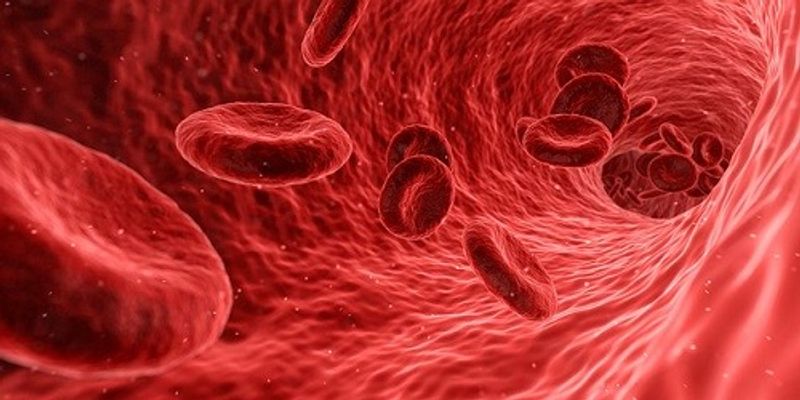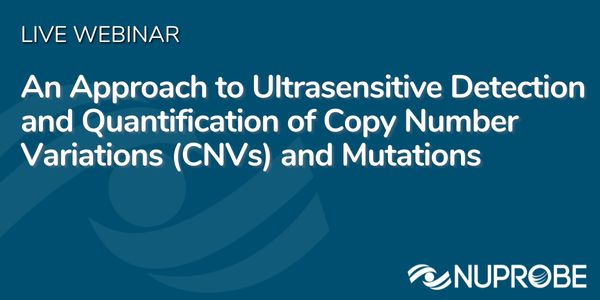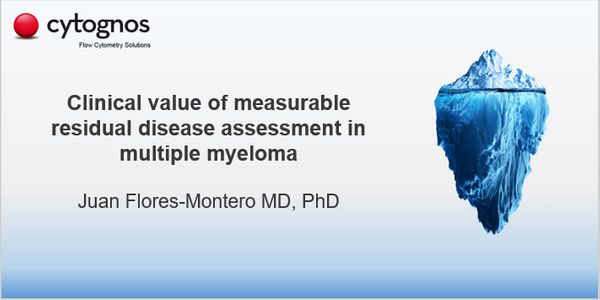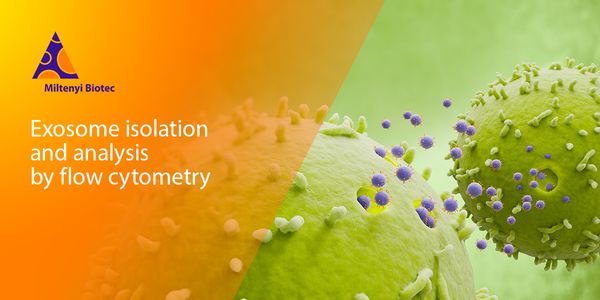Liquid Biopsy
A liquid biopsy is a diagnostic test using liquid biological samples. Considered non-invasive, it can be used to track cancers, heart issues, and do prenatal diagnosis.
-
FEB 09, 2022 | 9:00 AMDate: February 09, 2021 Time: 09:00am (PST), 12:00pm (EST) In this webinar we introduce quantitative amplicon sequencing (QASeq): a highly-sensitive and robust NGS-based method for the detec...NOV 30, 2021 | 11:00 AMDate: November 30, 2021 Time: 11:00am (PDT), 2:00pm (EDT) In the recent years, measurable residual disease (MRD) assessment on multiple myeloma patients has gained increasing relevance. After...NOV 17, 2021 | 8:00 AMDate: November 17, 2021 Time: 8:00am (PDT), 11:00am (EDT) From waste disposal to promising biomarkers and therapeutic agents, exosomes and other extracellular vesicles are valuable in resear...Speaker: Ariadna Pascual Velazquez , Laura Müller , Stefan Wild, PhDSponsored By: Miltenyi BiotecAUG 24, 2021 | 8:00 AMDate: August 24, 2021 Time: 8:00am (PST), 11:00am (EST) Liver cancer is the third cause of cancer-related mortality worldwide. Most patients have chronic liver disease, which has allowed...JUN 16, 2021 | 7:00 AMDate: June 16, 2021 Time: 7:00am (PDT), 10:00am (EDT) Non-small cell lung cancer (NSCLC) has become an important example of precision medicine among solid tumor malignancies. Next-generation...JUN 08, 2021 | 9:00 AMDate: June 8, 2021 Time: 9:00am PDT Reducing the spread of highly infectious and deadly diseases within the population, vaccine development is crucial in saving millions of lives each year....Speaker: Laura Chapman , Ketil Pedersen, Ph.D , Alexander "Sasha" Vlassov , Matt MckennaSponsored By: Thermo Fisher ScientificAPR 21, 2021 | 12:00 AMAccording to the American Cancer Society, in there were an estimated 110,070 new cases diagnosed and approximately 32,120 deaths from gynecologic cancers in the U.S. in 2018. Of the five mos...APR 20, 2021 | 3:00 PMBridging a deep understanding of molecular profiles with clinical information is critical to developing innovative precision medicine tools in oncology. Discovery’s recently launched S...Speaker: Nathan Henson, MS , Donald Skifter, PhD, MBANOV 12, 2020 | 10:30 AMCell-free DNA (cfDNA) is a key analyte for liquid biopsy samples. Due to extremely low concentration and high degree of fragmentation, the extraction of cfDNA is technically challenging. Her...Speaker: Alexander Wolf, PhDNOV 12, 2020 | 12:00 AMImmunohistochemistry (IHC) is used to determine spatial relationships where we can identify the localization of target proteins in specific regions and cells of a tissue. IHC has been the go...NOV 05, 2020 | 12:00 AMDr. Bacher will be discussing the history and evolution of MSI, the differences between popular testing methods, and what the future holds for this powerful biomarker....OCT 08, 2020 | 6:00 PMWhile circulating cell-free DNA (ccfDNA) and to some extend CTCs from blood are routinely used as analyte in liquid biopsy cancer research applications, circulating cell-free RNA (ccfRNA) ha...Speaker: Thorsten Voss, PhDOCT 08, 2020 | 6:00 PMSoluble cytokine biomarkers are the master regulators of cell-to-cell communication-- the means by which one cell tells another what to do or where to go. Determining the biomarker signature...Speaker: Jenny Koenitzer, PhDOCT 08, 2020 | 4:30 PMMultiplex detection of oncogenic mutations using LNA-based assays on the QIAcuity digital PCR system Digital PCR (dPCR) enables specific and sensitive detection of genetic alterations in onc...Speaker: Dr. Özlem KaralayOCT 08, 2020 | 3:00 PMThe continued rapid expansion of immunotherapies, including both in vivo and ex vivo therapeutics, has driven the development and adoption of novel tools to study, asses and understand these...Speaker: Benjamin Borgo, PhDOCT 08, 2020 | 1:30 PMMartin highlights various factors impacting molecular analysis from FFPE samples and key challenges and considerations while working with this precious yet challenging sample type. Learning...Speaker: Martin Schlumpberger, PhDOCT 08, 2020 | 12:00 PMAntibodies have become one of the most important tools in life science research, allowing the detection, quantitation, and determination of changes in proteins and other molecules with respe...Speaker: Wayne Speckmann, PhDOCT 08, 2020 | 10:30 AMImmunohistochemistry (IHC) is used to determine spatial relationships where we can identify the localization of target proteins in specific regions and cells of a tissue. IHC has been the go...Speaker: Vivian Barry, MSPresented at: Cancer Research & Oncology Week Virtual Event Series 2020
Sponsored By: Roche DiagnosticsOCT 08, 2020 | 10:00 AMDATE: October 8, 2020 TIME: 1:00pm PDT Microsatellite instability (MSI) has evolved as a marker of potential hereditary cancer risk and is now a tissue agnostic immune biomarker with a broad...OCT 08, 2020 | 9:00 AMMutations in the epidermal growth factor receptor gene (EGFR) and the known Kirsten rat sarcoma viral oncogene (KRAS) are significant drivers in the development of non-small-cell lung cancer...Speaker: Hestia Mellert, PhDPresented at: Cancer Research & Oncology Week Virtual Event Series 2020
Sponsored By: Bio-Rad LaboratoriesOCT 08, 2020 | 7:30 AMIndividuals of under-represented minority ancestry are at disproportional risk for higher incidence and mortality rates for particular cancers. The unequal burden of cancer in certain racial...Speaker: Steven R. Patierno, PhDOCT 08, 2020 | 6:00 AMEvery patient is different and so is every tumor! The term “personalized oncology” today is largely associated with sequencing approaches. Current publications proof more and mor...Speaker: Christian Regenbrecht, PhDPresented at: Cancer Research & Oncology Week Virtual Event Series 2020
Sponsored By: Luminex - A DiaSorin CompanyOCT 08, 2020 | 12:00 AMLearning Objectives: 1. Understand the evolving epidemiology of prostate cancer in the the US and globally, and the excess burden of disease borne by men of African ancestry 2. Describe the...Speaker: Matthew R. Cooperberg, MDOCT 08, 2020 | 12:00 AMBackground: Healthcare access (HCA) encompasses five important dimensions: Affordability, Availability, Accessibility, Accommodation and Acceptability. Published studies of cancer typically...Speaker: Tomi Akinyemiju, PhD, MS
FEB 09, 2022 | 9:00 AM
Date: February 09, 2021 Time: 09:00am (PST), 12:00pm (EST) In this webinar we introduce quantitative amplicon sequencing (QASeq): a highly-sensitive and robust NGS-based method for the detec...
NOV 30, 2021 | 11:00 AM
Date: November 30, 2021 Time: 11:00am (PDT), 2:00pm (EDT) In the recent years, measurable residual disease (MRD) assessment on multiple myeloma patients has gained increasing relevance. After...
NOV 17, 2021 | 8:00 AM
Date: November 17, 2021 Time: 8:00am (PDT), 11:00am (EDT) From waste disposal to promising biomarkers and therapeutic agents, exosomes and other extracellular vesicles are valuable in resear...
Speaker:
Ariadna Pascual Velazquez
, Laura Müller
, Stefan Wild, PhD
Sponsored By: Miltenyi Biotec
AUG 24, 2021 | 8:00 AM
Date: August 24, 2021 Time: 8:00am (PST), 11:00am (EST) Liver cancer is the third cause of cancer-related mortality worldwide. Most patients have chronic liver disease, which has allowed...
JUN 16, 2021 | 7:00 AM
Date: June 16, 2021 Time: 7:00am (PDT), 10:00am (EDT) Non-small cell lung cancer (NSCLC) has become an important example of precision medicine among solid tumor malignancies. Next-generation...
JUN 08, 2021 | 9:00 AM
Date: June 8, 2021 Time: 9:00am PDT Reducing the spread of highly infectious and deadly diseases within the population, vaccine development is crucial in saving millions of lives each year....
Speaker:
Laura Chapman
, Ketil Pedersen, Ph.D
, Alexander "Sasha" Vlassov
, Matt Mckenna
Sponsored By: Thermo Fisher Scientific
APR 21, 2021 | 12:00 AM
According to the American Cancer Society, in there were an estimated 110,070 new cases diagnosed and approximately 32,120 deaths from gynecologic cancers in the U.S. in 2018. Of the five mos...
APR 20, 2021 | 3:00 PM
Bridging a deep understanding of molecular profiles with clinical information is critical to developing innovative precision medicine tools in oncology. Discovery’s recently launched S...
Speaker:
Nathan Henson, MS
, Donald Skifter, PhD, MBA
NOV 12, 2020 | 10:30 AM
Cell-free DNA (cfDNA) is a key analyte for liquid biopsy samples. Due to extremely low concentration and high degree of fragmentation, the extraction of cfDNA is technically challenging. Her...
Speaker:
Alexander Wolf, PhD
NOV 12, 2020 | 12:00 AM
Immunohistochemistry (IHC) is used to determine spatial relationships where we can identify the localization of target proteins in specific regions and cells of a tissue. IHC has been the go...
NOV 05, 2020 | 12:00 AM
Dr. Bacher will be discussing the history and evolution of MSI, the differences between popular testing methods, and what the future holds for this powerful biomarker....
OCT 08, 2020 | 6:00 PM
While circulating cell-free DNA (ccfDNA) and to some extend CTCs from blood are routinely used as analyte in liquid biopsy cancer research applications, circulating cell-free RNA (ccfRNA) ha...
Speaker:
Thorsten Voss, PhD
OCT 08, 2020 | 6:00 PM
Soluble cytokine biomarkers are the master regulators of cell-to-cell communication-- the means by which one cell tells another what to do or where to go. Determining the biomarker signature...
Speaker:
Jenny Koenitzer, PhD
OCT 08, 2020 | 4:30 PM
Multiplex detection of oncogenic mutations using LNA-based assays on the QIAcuity digital PCR system Digital PCR (dPCR) enables specific and sensitive detection of genetic alterations in onc...
Speaker:
Dr. Özlem Karalay
OCT 08, 2020 | 3:00 PM
The continued rapid expansion of immunotherapies, including both in vivo and ex vivo therapeutics, has driven the development and adoption of novel tools to study, asses and understand these...
Speaker:
Benjamin Borgo, PhD
OCT 08, 2020 | 1:30 PM
Martin highlights various factors impacting molecular analysis from FFPE samples and key challenges and considerations while working with this precious yet challenging sample type. Learning...
Speaker:
Martin Schlumpberger, PhD
OCT 08, 2020 | 12:00 PM
Antibodies have become one of the most important tools in life science research, allowing the detection, quantitation, and determination of changes in proteins and other molecules with respe...
Speaker:
Wayne Speckmann, PhD
OCT 08, 2020 | 10:30 AM
Immunohistochemistry (IHC) is used to determine spatial relationships where we can identify the localization of target proteins in specific regions and cells of a tissue. IHC has been the go...
Speaker:
Vivian Barry, MS
Presented at: Cancer Research & Oncology Week Virtual Event Series 2020
Sponsored By: Roche Diagnostics
Sponsored By: Roche Diagnostics
OCT 08, 2020 | 10:00 AM
DATE: October 8, 2020 TIME: 1:00pm PDT Microsatellite instability (MSI) has evolved as a marker of potential hereditary cancer risk and is now a tissue agnostic immune biomarker with a broad...
OCT 08, 2020 | 9:00 AM
Mutations in the epidermal growth factor receptor gene (EGFR) and the known Kirsten rat sarcoma viral oncogene (KRAS) are significant drivers in the development of non-small-cell lung cancer...
Speaker:
Hestia Mellert, PhD
Presented at: Cancer Research & Oncology Week Virtual Event Series 2020
Sponsored By: Bio-Rad Laboratories
Sponsored By: Bio-Rad Laboratories
OCT 08, 2020 | 7:30 AM
Individuals of under-represented minority ancestry are at disproportional risk for higher incidence and mortality rates for particular cancers. The unequal burden of cancer in certain racial...
Speaker:
Steven R. Patierno, PhD
OCT 08, 2020 | 6:00 AM
Every patient is different and so is every tumor! The term “personalized oncology” today is largely associated with sequencing approaches. Current publications proof more and mor...
Speaker:
Christian Regenbrecht, PhD
Presented at: Cancer Research & Oncology Week Virtual Event Series 2020
Sponsored By: Luminex - A DiaSorin Company
Sponsored By: Luminex - A DiaSorin Company
OCT 08, 2020 | 12:00 AM
Learning Objectives: 1. Understand the evolving epidemiology of prostate cancer in the the US and globally, and the excess burden of disease borne by men of African ancestry 2. Describe the...
Speaker:
Matthew R. Cooperberg, MD
OCT 08, 2020 | 12:00 AM
Background: Healthcare access (HCA) encompasses five important dimensions: Affordability, Availability, Accessibility, Accommodation and Acceptability. Published studies of cancer typically...
Speaker:
Tomi Akinyemiju, PhD, MS























